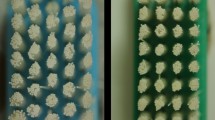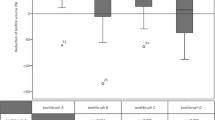Abstract
Objective
This study investigated the effect of toothbrush stiffness and dentifrice slurry abrasivity on the development and progression of simulated non-carious cervical lesions (NCCLs).
Materials and methods
Human maxillary premolars were allocated to 12 groups generated by the association between toothbrushes, soft, medium, and hard stiffness, and simulated dentifrice slurries, lower, medium, and higher; deionized water (DI) served as negative control. Teeth were mounted on acrylic blocks, and their root surfaces partially covered with acrylic resin to simulate gingiva, leaving a 2-mm area apical to the cemento-enamel junction exposed to toothbrushing. Specimens were brushed with the test slurries for 35,000 and 65,000 double strokes. Impressions taken at baseline and after both brushing periods were scanned by a 3D optical profilometer. Dentin volume loss (mm3) was calculated by image subtraction. Data were analyzed using three-way ANOVA and Fisher’s PLSD tests.
Results
All toothbrushes caused higher volume loss when associated to higher abrasive slurry, compared to medium- and lower-abrasive slurries. Medium caused more volume loss than lower-abrasive slurry, which led to more volume loss than DI. Hard and medium toothbrushes were not different when used with medium- or higher-abrasive slurries. There were no differences among toothbrushes when used with DI and lower-abrasive slurry. Overall, 35,000 brushing strokes resulted in significantly less volume loss than 65,000.
Conclusions
Toothbrush stiffness was an important factor on NCCL development, especially when brushing with medium- and higher-abrasive slurries.
Clinical relevance
Medium and hard toothbrushes associated with medium- and high-abrasive toothpastes can yield more severe NCCLs.
Similar content being viewed by others
References
Wood I, Jawad Z, Paisley C, Brunton P (2008) Non-carious cervical tooth surface loss: a literature review. J Dent 36:759–766. https://doi.org/10.1016/j.jdent.2008.06.004
Levitch LC, Bader JD, Shugars DA, Heymann HO (1994) Non-carious cervical lesions. J Dent 22:195–207
Que K, Guo B, Jia Z, Chen Z, Yang J, Gao P (2013) A cross-sectional study: non-carious cervical lesions, cervical dentine hypersensitivity and related risk factors. J Oral Rehabil 40:24–32. https://doi.org/10.1111/j.1365-2842.2012.02342.x
Bartlett DW, Lussi A, West NX, Bouchard P, Sanz M, Bourgeois D (2013) Prevalence of tooth wear on buccal and lingual surfaces and possible risk factors in young European adults. J Dent 41:1007–1013. https://doi.org/10.1016/j.jdent.2013.08.018
Walter C, Kress E, Götz H, Taylor K, Willershausen I, Zampelis A (2014) The anatomy of non-carious cervical lesions. Clin Oral Investig 18:139–146. https://doi.org/10.1007/s00784-013-0960-0
Litonjua LA, Andreana S, Bush PJ, Tobias TS, Cohen RE (2004) Wedged cervical lesions produced by toothbrushing. Am J Dent 17:237–240
Wiegand A, Schlueter N (2014) The role of oral hygiene: does toothbrushing harm? Monogr Oral Sci 25:215–219. https://doi.org/10.1159/000360379
Sabrah AH, Turssi CP, Lippert F, Eckert GJ, Kelly AB, Hara AT (2018) 3D-image analysis of the impact of toothpaste abrasivity on the progression of simulated non-carious cervical lesions. J Dent 73:14–18. https://doi.org/10.1016/j.jdent.2018.03.012
Heasman PA, Holliday R, Bryant A, Preshaw PM (2015) Evidence for the occurrence of gingival recession and non-carious cervical lesions as a consequence of traumatic toothbrushing. J Clin Periodontol 42 Suppl 16:S237–S255. https://doi.org/10.1111/jcpe.12330
de Boer P, Duinkerke AS, Arends J (1985) Influence of tooth paste particle size and tooth brush stiffness on dentine abrasion in vitro. Caries Res 19:232–239
Lippert F, Arrageg MA, Eckert GJ, Hara AT (2017) Interaction between toothpaste abrasivity and toothbrush filament stiffness on the development of erosive/abrasive lesions in vitro. Int Dent J 67:344–350. https://doi.org/10.1111/idj.12305
Wiegand A, Kuhn M, Sener B, Roos M, Attin T (2009) Abrasion of eroded dentin caused by toothpaste slurries of different abrasivity and toothbrushes of different filament diameter. J Dent 37:480–448. https://doi.org/10.1016/j.jdent.2009.03.005
Bizhang M, Riemer K, Arnold WH, Domin J, Zimmer S (2016) Influence of bristle stiffness of manual toothbrushes on eroded and sound human dentin—an in vitro study. PLoS One 11:e0153250. https://doi.org/10.1371/journal.pone.0153250
Dzakovich JJ, Oslak RR (2008) In vitro reproduction of noncarious cervical lesions. J Prosthet Dent 100:1–10
Heath JR, Wilson HJ (1974) Forces and rates observed during in vivo toothbrushing. Biomed Eng 9:61–64
Van der Weijden GA, Timmerman MF, Nijboer A, Lie MA, Van der Velden U (1993) A comparative study of electric toothbrushes for the effectiveness of plaque removal in relation to toothbrushing duration. Timerstudy. J Clin Periodontol 20:476–481
Wiegand A, Burkhard JP, Eggmann F, Attin T (2013) Brushing force of manual and sonic toothbrushes affects dental hard tissue abrasion. Clin Oral Investig 17:815–822. https://doi.org/10.1007/s00784-012-0788-z
Wiegand A, Attin T (2011) Design of erosion/abrasion studies—insights and rational concepts. Caries Res 45(Suppl 1):53–59. https://doi.org/10.1159/000325946
Ganss C, Duran R, Winterfeld T, Schlueter N (2018) Tooth brushing motion patterns with manual and powered toothbrushes—randomised video observation study. Clin Oral Investig 22:715–720. https://doi.org/10.1007/s00784-017-2146-7
Bergström J, Lavstedt S (1979) An epidemiologic approach to toothbrushing and dental abrasion. Community Dent Oral Epidemiol 7:57–64
Dyer D, Addy M, Newcombe RG (2000) Studies in vitro of abrasion by different manual toothbrush heads and a standard toothpaste. J Clin Periodontol 27:99–103
Hooper S, West NX, Pickles MJ, Joiner A, Newcombe RG, Addy M (2003) Investigation of erosion and abrasion on enamel and dentine: a model in situ using toothpastes of different abrasivity. J Clin Periodontol 30:802–808
Joiner A, Schwarz A, Philpotts CJ, Cox TF, Huber K, Hannig M (2008) The protective nature of pellicle towards toothpaste abrasion on enamel and dentine. J Dent 36:360–368. https://doi.org/10.1016/j.jdent.2008.01.010
Acknowledgments
This research was part of Fahad Binsaleh’s thesis submitted in partial fulfillment of the MSD in Operative Dentistry degree awarded in 2016 from Indiana University School of Dentistry (IUSD). The authors would like to thank Dr. Norman Blaine Cook and Dr. Kim E. Diefenderfer for their insightful comments and feedback.
Funding
This study was supported by the Dental Erosion-Abrasion Program of the Oral Health Research Institute, Indiana University School of Dentistry, Indianapolis, IN, USA.
Author information
Authors and Affiliations
Corresponding author
Ethics declarations
Conflict of interest
The authors declare that they have no conflict of interest.
Ethical approval
All procedures performed were in accordance with the ethical standards of the institutional and/or national research committee and with the 1964 Helsinki declaration and its later amendments or comparable ethical standards.
Informed consent
For this type of study, formal consent is not required.
Rights and permissions
About this article
Cite this article
Turssi, C.P., Binsaleh, F., Lippert, F. et al. Interplay between toothbrush stiffness and dentifrice abrasivity on the development of non-carious cervical lesions. Clin Oral Invest 23, 3551–3556 (2019). https://doi.org/10.1007/s00784-018-2776-4
Received:
Accepted:
Published:
Issue Date:
DOI: https://doi.org/10.1007/s00784-018-2776-4




